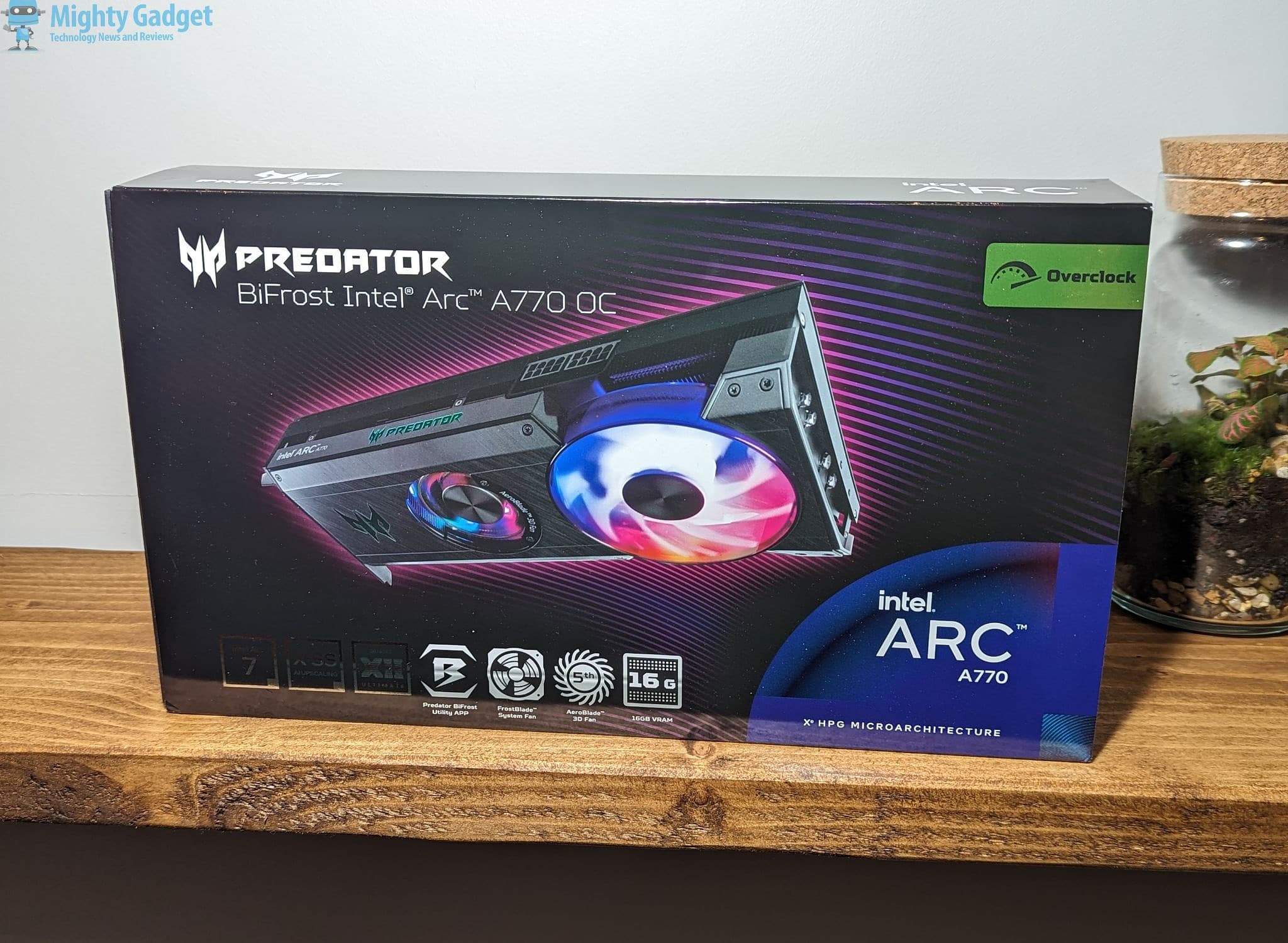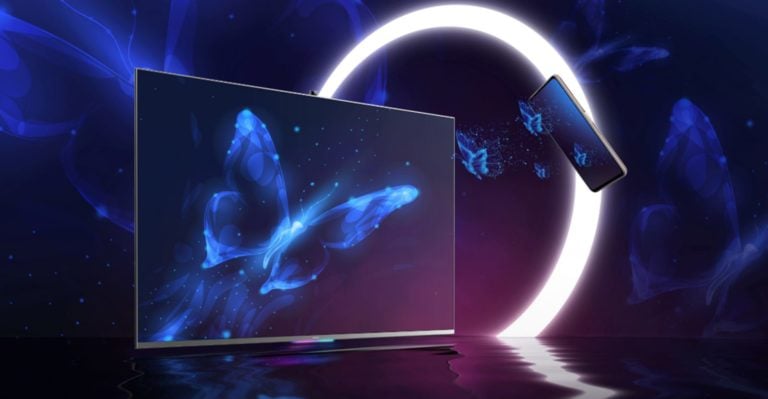Any links to online stores should be assumed to be affiliates. The company or PR agency provides all or most review samples. They have no control over my content, and I provide my honest opinion.
The Intel Arc A750 and A770 GPUs officially launched in October 2022, with Acer and Asrock being the only third-party brands to launch their own models.
At the time of writing, this BiFrost Arc A770 is priced at around £400, which is about the same price as the more affordable GeForce RTX 3060 Ti cards or the AMD Radeon RX 6700 XT.
Specification
- Memory: 16GB 256-Bit GDDR6
- Core Clock: 2200 MHz
- Boost Clock: 2400 MHz
- TDP: 225W
- 1 x HDMI 2.1
- 3 x DisplayPort 2.0
Design / Build Quality
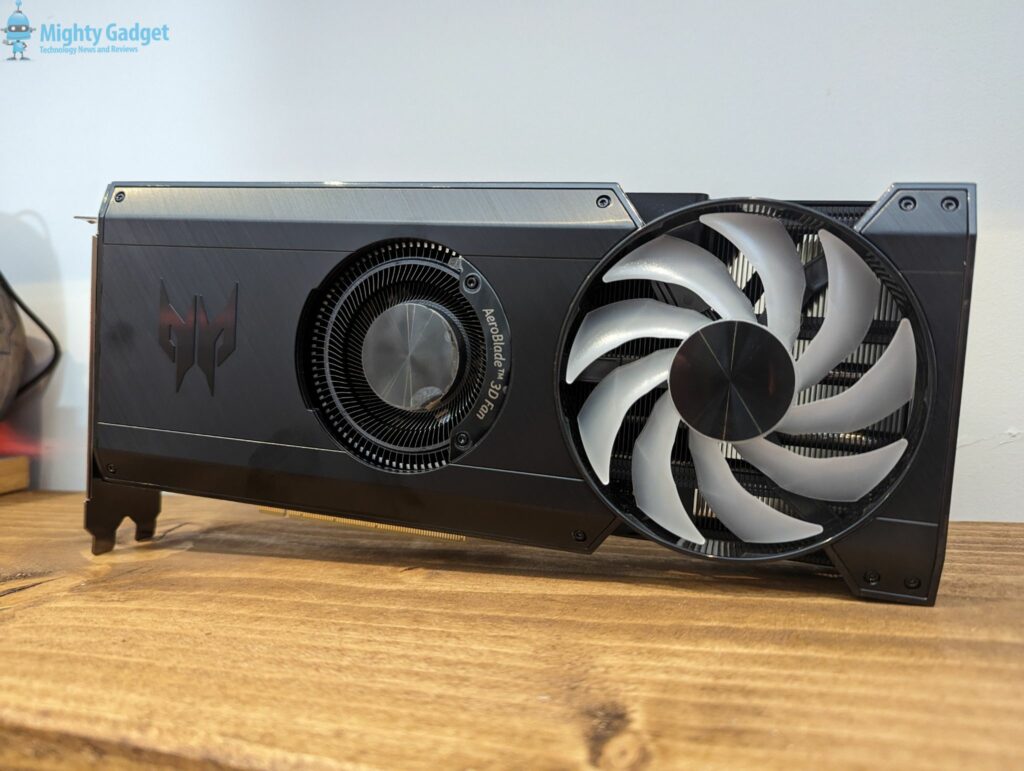
One thing I have noticed online is that everyone seems to love the design of the BitFrost GPU, and it is regularly complimented for the quality of the metal GPU shroud. Many of the premium-priced Nvidia GPUs have questionable build quality, so this is why many people are so happy that a mid-priced GPU from Acer can look and feel so premium.
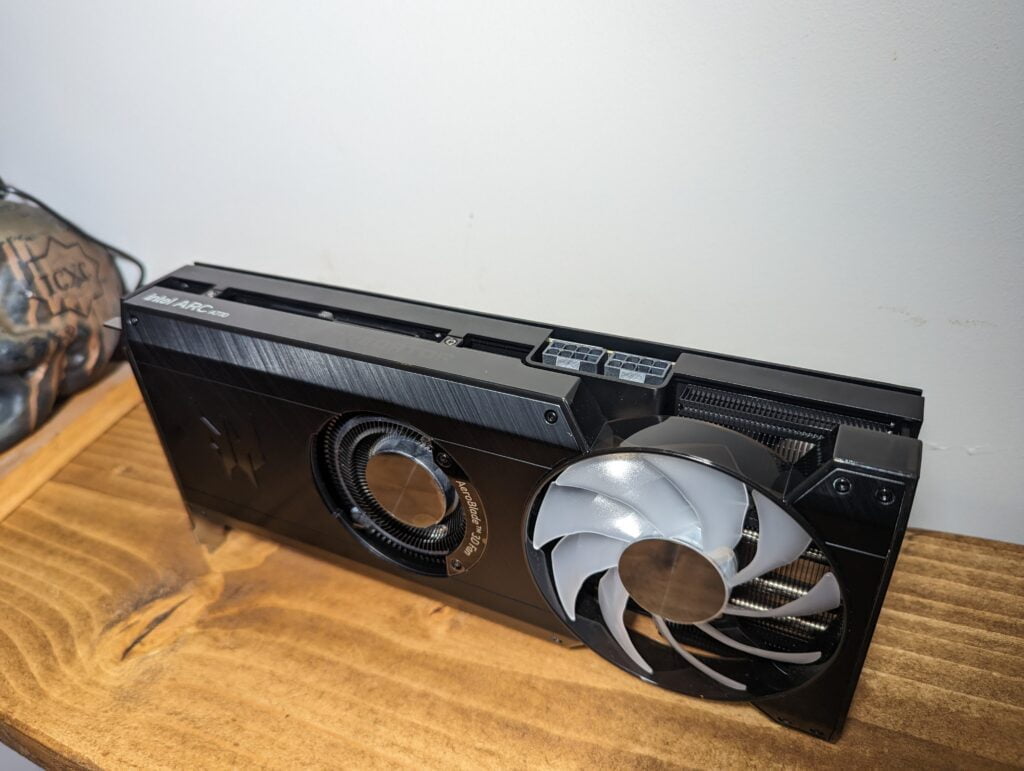
This is a two-slot width GPU with a length of 267 mm. You have four display outputs with three DisplayPort 2.0 and a single HDMI 2.1. As you’d expect, this uses PCI Express 4.0 x16.
The GPU has two fans. The first is the unique looking 70mm blower fan that Acer call a Predator AeroBlade 3D. This uses 89 ultra-thin curved steel blades, which Acer claims to be able to improve heat dissipation by 55%. It is then paired up with a 92mm axial fan which Acer says is a Bionic-inspired design for high static pressure and minimal vibration.
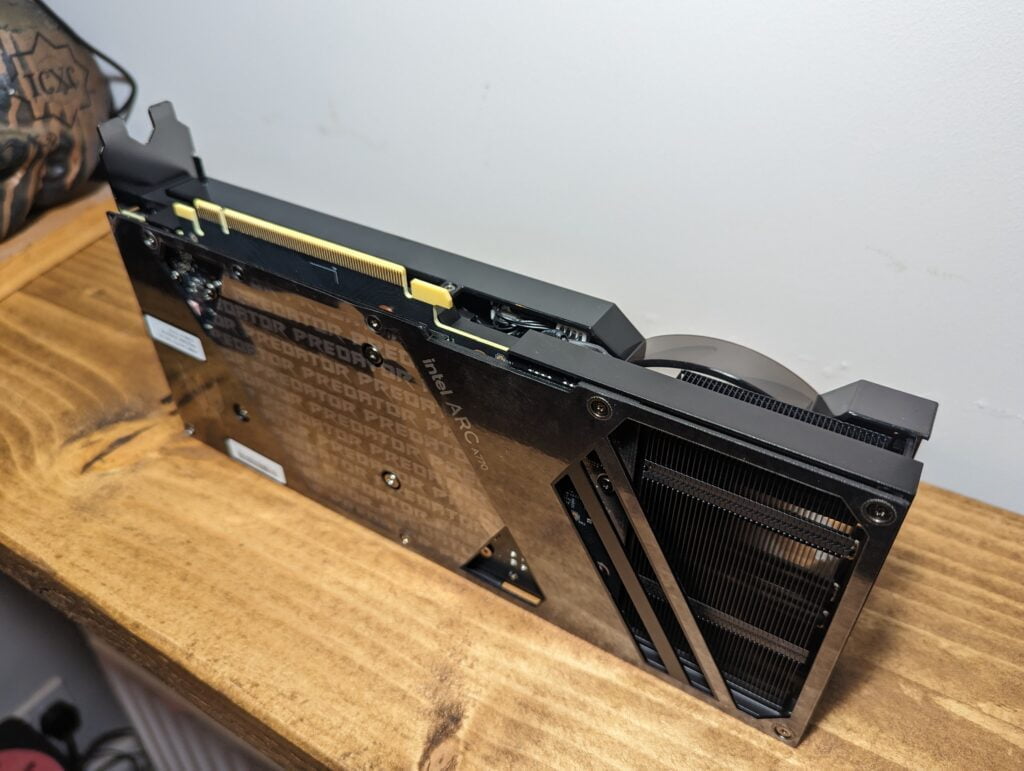
On the rear of the GPU, you have a double backplate which both stiffens the PCB and provides some additional cooling to the rear.
Acer has incorporated a vapour chamber into the radiator of this GPU. They claim this is rarely used on GPUs and will assist with streamlining the airflow to circulate airflow quickly and efficiently. It is worth noting that the Intel Arc A770 16GB Limited Edition also uses a copper vapour chamber design, so it is not that unique.

For power, this has 2 x 8-Pin connectors and the TDP is rated at 225W with a recommended PSU of 650W. The reference Intel Arc A770 only requires a 1x 8-pin and 1x 6-pin connector.
Both fans and the logo on the top of the card have RGB that can be customised via the Acer Predator Bitfrost application. These can all be synced, or you can manually assign lighting effects or a static colour to each element.
Features
I won’t cover the technical aspect in much detail, but this card uses the 6nm manufacturing process by TSMC. It then has 32 Xe Cores, 32 Ray Tracing units and 512 XMX Engines.
For memory, it has 16 GB of 256-bit GDDR6, which provides 560 GB/s of bandwidth.
The stock Intel Arc A770 has a base clock of 2,100MHz and a boost of 2,400 MHz, whereas the BiFrost Arc A770 has a base speed of 2,200 MHz and can boost to 2,400 MHz.
One of the selling points of Intel Arc has been the inclusion of AV1 encoding/decoding. Most newish GPUs supported decoding, but Intel were the first to support encoding. Nvidia introduced this with the RTX 40-series, but for the time being, the cheapest 40-series card is around £780.
The Intel Alchemist Architecture fully supports Ray Tracing. It also has Intel XeSS upscaling technology which is supposed to be a competitor to DLSS and FSR.
Predator BiFrost Software
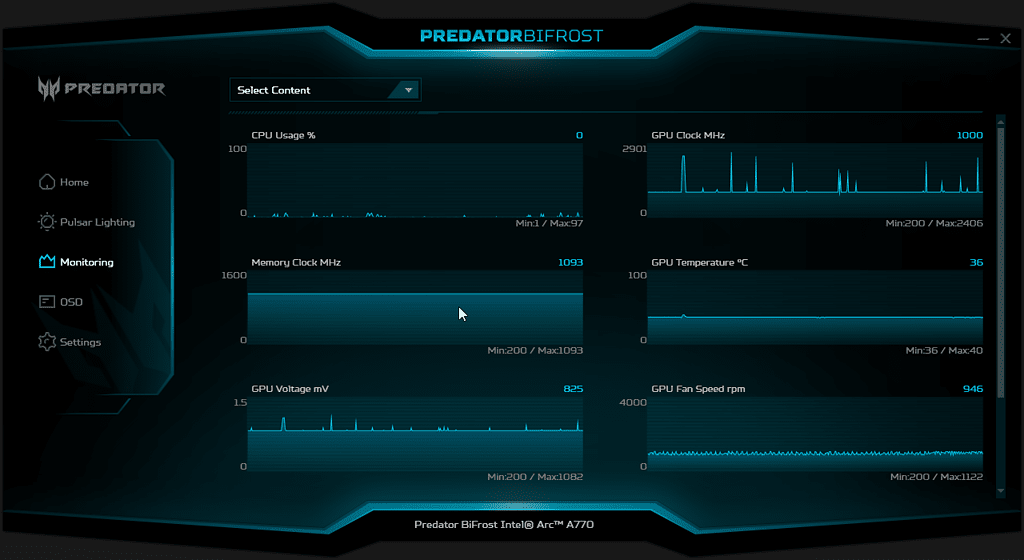
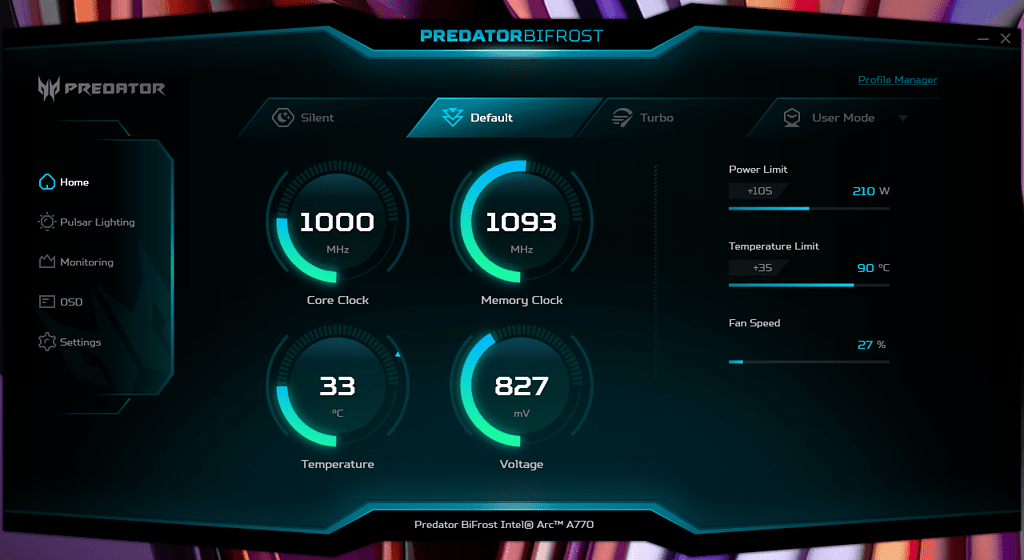
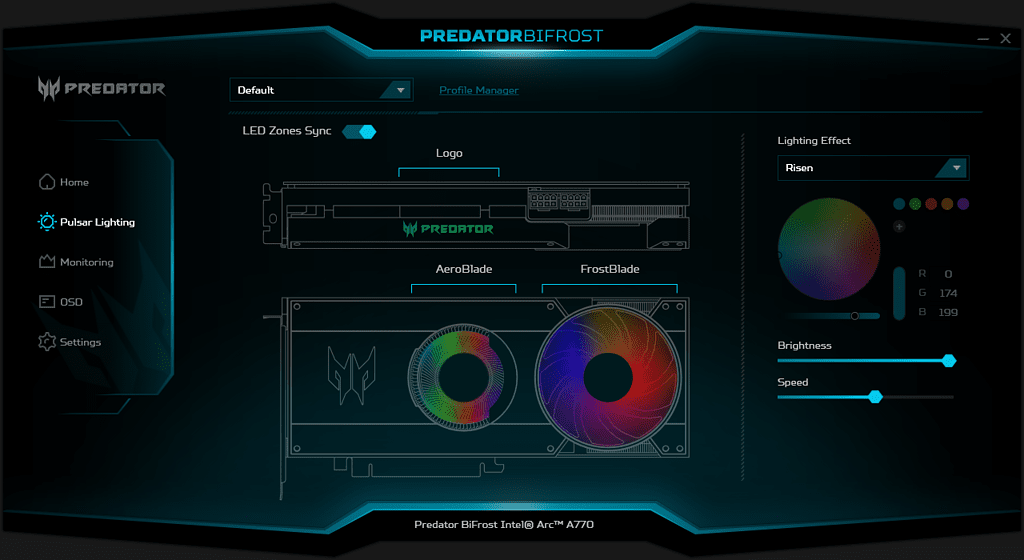
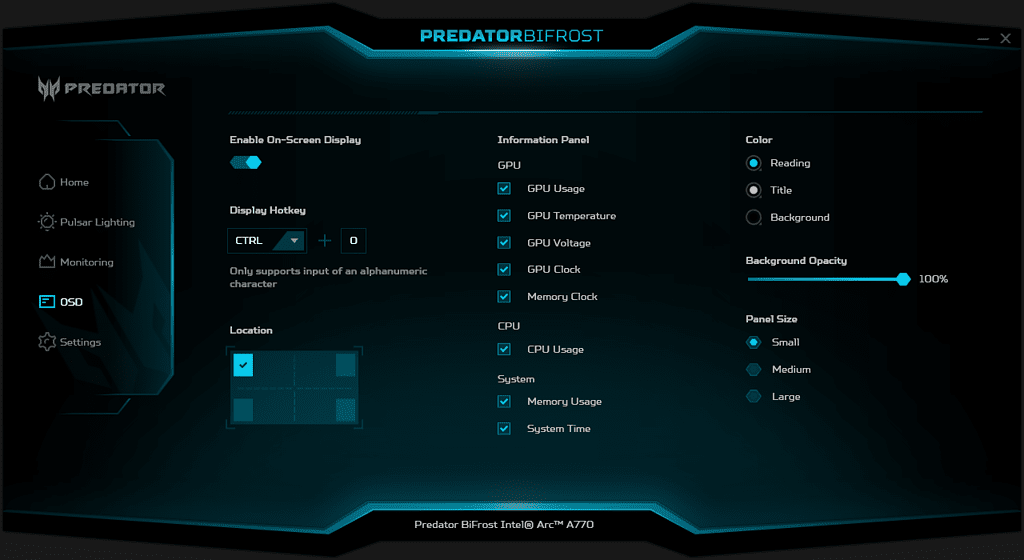
Acer includes a thumb drive with the GPU containing the Intel drivers and the Predator BiFrost software.
This is used for basic overclocking, RGB customisation and system monitoring. It is nicely designed software that’s easy to use. They also have a handy option for an OCD overlay which will display the GPU usage, temperature, clock, memory clock and CPU/RAM usage.
The GPU is rated at 225W, but under the power limits, the silent option is 160W, the default is 210W, and turbo goes up to 235W.
You can also manually adjust the settings, including temperature limit and fan speed. The settings are quite basic. There is no fan curve or anything like that. It is easy to use, though.
Under lighting, you have control over the three RGB zones, you can either sync them or set them up individually with options for static colours or 5 different effects.
Under monitoring, you get all the stats you would expect, and the OSD option will allow you to display the current usage on screen. You can only position it in the corners of the active display, but it is useful to have when testing.
It is worth noting that Intel also has their own software to customise the performance of the card. This has superior features for tuning, and you can dial up the power limit to 252w.
Test System
- AMD Ryzen 7 5800X
- MSI MEG X570 Unifi
- Kingston Fury Renegade 3600Mhz RGB DDR4 CL16
- Kingston FURY Renegade PCIe 4.0 NVMe 2TB
My system was running the Zotac Gaming GeForce RTX 3080 Trinity, but it unfortunately died, and CCL decided to refund me rather than replace it. As they took well over a month to deal with the RMA, I have been hobbling along with an old AMD Radeon RX 480, which is perfectly good for day-to-day work, less so for gaming.
Teething Problems – Intermittent black screens and Resizable BAR
I experienced some problems running this GPU in my main system at first. I would get intermittent black screens which seemed to occur most when I was streaming DRM content. In particular, it happened a lot with Disney+.
I would also get some visual glitches in various applications.
One likely scenario was that Resizable BAR was not enabled. Even though I enabled it within the BIOS, GPU-Z and the Intel Arc software kept reporting that it was disabled. I eventually had to update my BIOS, and I also enabled the above 4G option, which MSI appear to recommend.
People have also suggested it is cable and/or multi-monitor related or possibly due to the monitor refresh rate.
For me, updating the BIOS and making sure Resizable BAR was working appears to be the solution to the problem.
Resizable BAR Performance Difference
I didn’t specifically test the performance difference of the resizable BAR being on or off, but when I installed the GPU, I did do a quick benchmark within Time Spy.
Without resizable BAR enabled, I achieved 12166 in Time Spy. With it enabled, this increased to 13236, giving an 8.8% improvement in performance. The GPU section of the score went from 12323 to 14146, which is a 14.8% improvement.
Time Spy isn’t exactly the best benchmark, but it shows there is a significant performance improvement with resizable BAR enabled.
Benchmarks & Performance
This card is a midrange card and is best suited for 1080P or 1440P, which is how I have tested it.
3DMark

| BiFrost Arc A770 | RTX 3060 Ti | RX 6700 XT | |
|---|---|---|---|
| Time Spy | 13236 | 13051 | 12633 |
| Time Spy Extreme | 7001 | 6398 | 5937 |
| Fire Strike | 30115 | 26909 | 30573 |
| Fire Strike Ultra | 6984 | 7444 | 8606 |
| Port Royal | 7150 | 7192 | 6003 |
For the GPU comparison, I have taken the average score from the 3DMark database for test results with the same CPU as mine. It is not an ideal comparison, but it shows that the Intel Arc A770 is quite competitive with the other two GPUs.
Crysis Remastered Benchmark
- 1080P Very High: 76.99 fps
- 1440P Very High: 52.24 fps
The Crysis benchmarks ran well when testing at high and very high, but not the “can it run Crysis” setting.
Cyberpunk 2077
Cyberpunk 2077 is notoriously difficult to run. When it first came out, the RTX 3080 struggled to run at max settings for everything.
- 1080P Ultra RT Off: 53.61 fps
- 1440P Ultra RT Off: 30.72 fps
- 1080P Ultra RT On: 30.55 fps
The GPU performs well at 1080P, but I struggled to get a good FPS at 1440P, and the gaming is a bit too demanding to have ray tracing on.
FarCry 6
- 1080P Ultra: 80 fps
- 1440P Ultra: 105 fps
FarCry 6 is relatively easy to run for most mid-range GPUs, and the BiFrost Intel Arc A770 achieves admirable results.
Assassin’s Creed Valhalla
- 1080P Ultra: 66.3 fps
- 1440P Ultra: 43.4 fps
Assassin’s Creed Valhalla is playable up to 1440P, but the FPS can drop a little low at 1440P.
Power Draw / Heat / Noise
To test the power draw, heat and noise, I ran the Time Spy Extreme stress test and used both GPU-Z and the Intel Arc overlay to monitor the stats.
Even with BitFrost software set to performance, I didn’t see the GPU core power exceed 220w. The temperature hit 70 before it stabilised, and the fans span up to a bit over 3000rpm.
I don’t have a sound meter for the fans, I wouldn’t describe them as very loud. They are definitely less loud than my old Zotac RTX 3080. They have a mid-range pitch which isn’t awful and certainly better than some of the high-pitched fans you get.
At idle, the GPU shows around a 42W power draw with it running at about 34°C and the fans spinning at around 1200rpm. The GPU doesn’t appear to support semi-passive fans, but at their lowest RPM, I can’t hear them over my AIO cooler.
Price and Alternative Options
The Acer BiFrost Arc A770 is available from Acer for £450 or Ebuyer for £400.
The reference Intel Arc A770 16GB is around £360.
That puts the price close to the GeForce RTX 3060 Ti or the AMD Radeon RX 6700 XT.
The cheapest GeForce RTX 3060 Ti on Scan is a Zotac at £390, then an Asus at £410.
For the RX 6700 XT, there is the Asus Radeon RX 6700 XT Dual at £395.
Overall
The Intel Arc A770 16GB appears to be an excellent first attempt at an enthusiast-grade graphics card which is able to compete with similarly priced GPUs from Nvidia and AMD.
It has an advantage over Nvidia and AMD with the AV1 encoding, which will help to stream or record in better quality at the same bitrate compared to H.264/H.265.
Acer has done particularly well at producing its first GPU. It is an attractive card and has a premium build quality that puts many other Nvidia or AMD cards to shame.
Originally posted on mightygadget.com – Follow on Twitter – Instagram – Facebook – Mighty Gadget Latest Reviews
Acer Predator BiFrost Intel Arc A770 16GB OC Graphics Card Review Rating
Summary
The Intel Arc A770 16GB appears to be an excellent first attempt at an enthusiast-grade graphics card which is able to compete with similarly priced GPUs from Nvidia and AMD. Acer has done particularly well at producing its first GPU with an impressive build quality and attractive design.
Overall
85%-
Overall - 85%85%
I am James, a UK-based tech enthusiast and the Editor and Owner of Mighty Gadget, which I’ve proudly run since 2007. Passionate about all things technology, my expertise spans from computers and networking to mobile, wearables, and smart home devices.
As a fitness fanatic who loves running and cycling, I also have a keen interest in fitness-related technology, and I take every opportunity to cover this niche on my blog. My diverse interests allow me to bring a unique perspective to tech blogging, merging lifestyle, fitness, and the latest tech trends.
In my academic pursuits, I earned a BSc in Information Systems Design from UCLAN, before advancing my learning with a Master’s Degree in Computing. This advanced study also included Cisco CCNA accreditation, further demonstrating my commitment to understanding and staying ahead of the technology curve.
I’m proud to share that Vuelio has consistently ranked Mighty Gadget as one of the top technology blogs in the UK. With my dedication to technology and drive to share my insights, I aim to continue providing my readers with engaging and informative content.

